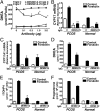Overexpression of a DENND1A isoform produces a polycystic ovary syndrome theca phenotype
- PMID: 24706793
- PMCID: PMC3992676
- DOI: 10.1073/pnas.1400574111
Overexpression of a DENND1A isoform produces a polycystic ovary syndrome theca phenotype
Abstract
Polycystic ovary syndrome (PCOS), characterized by increased ovarian androgen biosynthesis, anovulation, and infertility, affects 5-7% of reproductive-age women. Genome-wide association studies identified PCOS candidate loci that were replicated in subsequent reports, including DENND1A, which encodes a protein associated with clathrin-coated pits where cell-surface receptors reside. However, these studies provided no information about functional roles for DENND1A in the pathogenesis of PCOS. DENND1A protein was located in the cytoplasm as well as nuclei of theca cells, suggesting a possible role in gene regulation. DENND1A immunostaining was more intense in the theca of PCOS ovaries. Using theca cells isolated and propagated from normal cycling and PCOS women, we found that DENND1A variant 2 (DENND1A.V2) protein and mRNA levels are increased in PCOS theca cells. Exosomal DENND1A.V2 RNA was significantly elevated in urine from PCOS women compared with normal cycling women. Forced overexpression of DENND1A.V2 in normal theca cells resulted in a PCOS phenotype of augmented CYP17A1 and CYP11A1 gene transcription, mRNA abundance, and androgen biosynthesis. Knock-down of DENND1A.V2 in PCOS theca cells reduced androgen biosynthesis and CYP17A1 and CYP11A1 gene transcription. An IgG specific to DENND1A.V2 also reduced androgen biosynthesis and CYP17 and CYP11A1 mRNA when added to the medium of cultured PCOS theca cells. We conclude that the PCOS candidate gene, DENND1A, plays a key role in the hyperandrogenemia associated with PCOS. These observations have both diagnostic and therapeutic implications for this common disorder.
Conflict of interest statement
Conflict of interest statement: J.M.M. and J.F.S. have patents pending related to this material. J.F.S. is also a consultant to Takeda on topics of infertility treatment. R.S.L. consults for Euroscreen and AstraZeneca, and obtains research funding from Ferring.
Figures








Similar articles
-
miRNA Profiling Reveals miRNA-130b-3p Mediates DENND1A Variant 2 Expression and Androgen Biosynthesis.Endocrinology. 2019 Aug 1;160(8):1964-1981. doi: 10.1210/en.2019-00013. Endocrinology. 2019. PMID: 31184707 Free PMC article.
-
Human DENND1A.V2 Drives Cyp17a1 Expression and Androgen Production in Mouse Ovaries and Adrenals.Int J Mol Sci. 2020 Apr 6;21(7):2545. doi: 10.3390/ijms21072545. Int J Mol Sci. 2020. PMID: 32268539 Free PMC article.
-
Alternative splicing of DENND1A, a PCOS candidate gene, generates variant 2.Mol Cell Endocrinol. 2016 Oct 15;434:25-35. doi: 10.1016/j.mce.2016.06.011. Epub 2016 Jun 11. Mol Cell Endocrinol. 2016. PMID: 27297658 Free PMC article.
-
Cellular and Animal Studies: Insights into Pathophysiology and Therapy of PCOS.Best Pract Res Clin Obstet Gynaecol. 2016 Nov;37:12-24. doi: 10.1016/j.bpobgyn.2016.03.006. Epub 2016 Apr 1. Best Pract Res Clin Obstet Gynaecol. 2016. PMID: 27118251 Review.
-
Some new thoughts on the pathophysiology and genetics of polycystic ovary syndrome.Ann N Y Acad Sci. 2003 Nov;997:42-8. doi: 10.1196/annals.1290.005. Ann N Y Acad Sci. 2003. PMID: 14644808 Review.
Cited by
-
The contribution of rare genetic variants to the pathogenesis of polycystic ovary syndrome.Curr Opin Endocr Metab Res. 2020 Jun;12:26-32. doi: 10.1016/j.coemr.2020.02.011. Epub 2020 Apr 3. Curr Opin Endocr Metab Res. 2020. PMID: 32440573 Free PMC article.
-
A Comprehensive Overview of Common Polymorphic Variants in Genes Related to Polycystic Ovary Syndrome.Reprod Sci. 2021 Sep;28(9):2399-2412. doi: 10.1007/s43032-020-00375-4. Epub 2020 Nov 10. Reprod Sci. 2021. PMID: 33174186
-
Prenatal androgen exposure and transgenerational susceptibility to polycystic ovary syndrome.Nat Med. 2019 Dec;25(12):1894-1904. doi: 10.1038/s41591-019-0666-1. Epub 2019 Dec 2. Nat Med. 2019. PMID: 31792459
-
Translational Insight Into Polycystic Ovary Syndrome (PCOS) From Female Monkeys with PCOS-like Traits.Curr Pharm Des. 2016;22(36):5625-5633. doi: 10.2174/1381612822666160715133437. Curr Pharm Des. 2016. PMID: 27426126 Free PMC article. Review.
-
Family-Based Quantitative Trait Meta-Analysis Implicates Rare Noncoding Variants in DENND1A in Polycystic Ovary Syndrome.J Clin Endocrinol Metab. 2019 Sep 1;104(9):3835-3850. doi: 10.1210/jc.2018-02496. J Clin Endocrinol Metab. 2019. PMID: 31038695 Free PMC article.
References
-
- Dunaif A. Polycystic ovary syndrome in 2011: Genes, aging and sleep apnea in polycystic ovary syndrome. Nat Rev Endocrinol. 2012;8(2):72–74. - PubMed
-
- Balen A, Homburg R, Franks S. Defining polycystic ovary syndrome. BMJ. 2009;338:a2968. - PubMed
-
- Franks S, et al. Ovarian morphology is a marker of heritable biochemical traits in sisters with polycystic ovaries. J Clin Endocrinol Metab. 2008;93(9):3396–3402. - PubMed
-
- Franks S, Stark J, Hardy K. Follicle dynamics and anovulation in polycystic ovary syndrome. Hum Reprod Update. 2008;14(4):367–378. - PubMed
-
- Dunaif A, et al., editors. Polycystic Ovary Syndrome: Current Controversies, from the Ovary to the Pancreas. Totowa, NJ: Humana Press; 2008.
Publication types
MeSH terms
Substances
Grants and funding
LinkOut - more resources
Full Text Sources
Other Literature Sources
Medical

